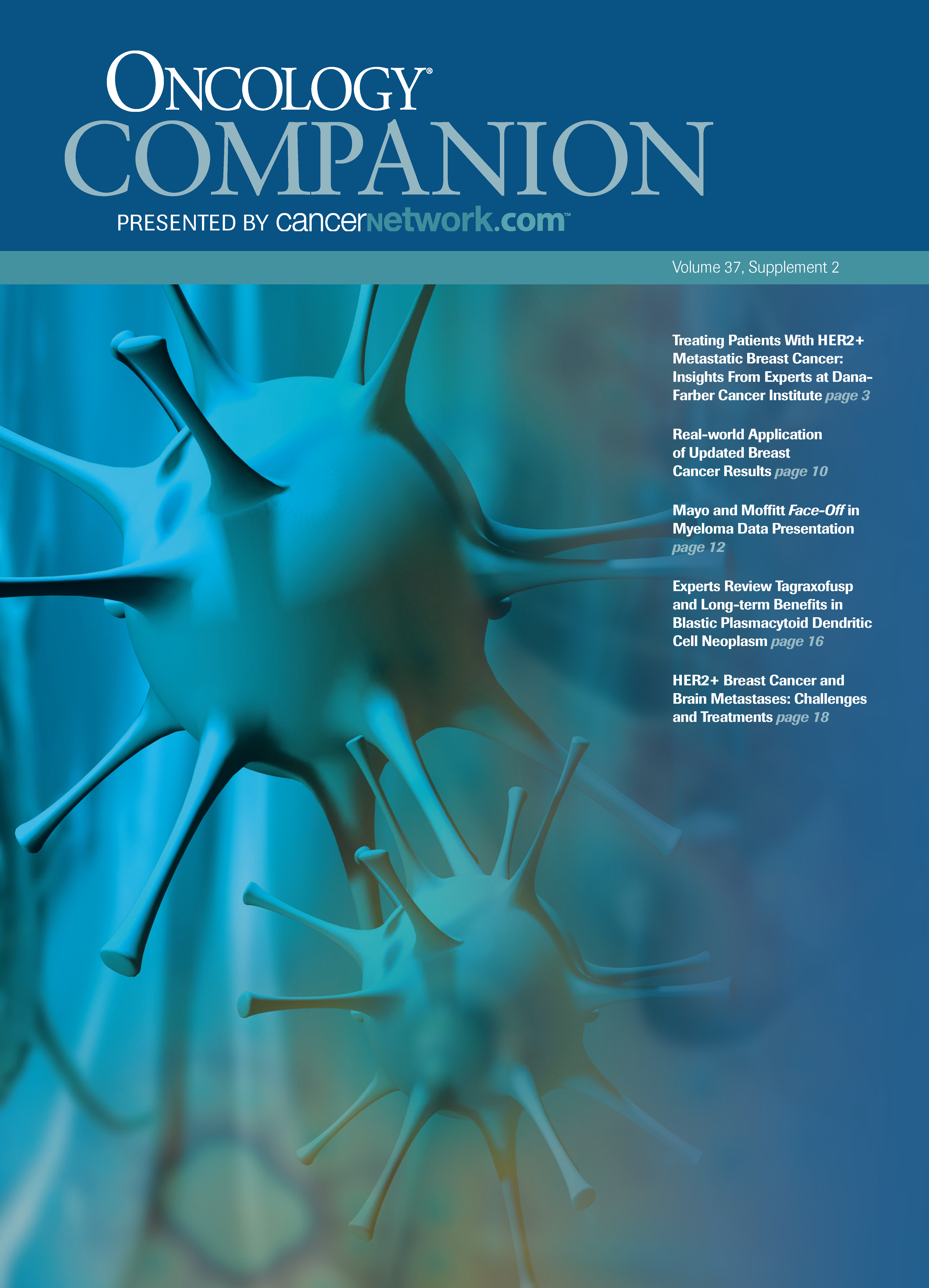Recap: Real-world Application of Updated Breast Cancer Results
Experts discuss updates in HR+ breast cancer, with a focus on treatment options before and after progression and emerging data.

Updated trial results, recently presented at the 2022 San Antonio Breast Cancer Symposium (SABCS), may lead to a new standard of care, and aid clinicians in their treatment decisions.
Virginia Kaklamani, MD, professor of medicine in the Division of Hematology/ Oncology at UT Health San Antonio and leader of the Breast Cancer Program at UT Health San Antonio MD Anderson Cancer Center; and Heather McArthur, MD, Komen Distinguished Chair in Clinical Breast Cancer Research at UT Southwestern Medical Center, examined the recent presentations during an OncView™ program hosted by CancerNetwork®.
The panelists examined the trials and talked through how they are implementing the findings into their practice. They also touched upon the treatment of women who are pre- or postmenopausal and how certain treatment decisions may be involved when patients are discussing future fertility.
13-Year Follow-up Data
McArthur and Kaklamani opened the conversation by discussing the 13-year follow-up to the combined SOFT plus TEXT analysis (NCT00066690 and NCT00066703, respectively).1 This analysis evaluated the use of the adjuvant aromatase inhibitor exemestane plus ovarian function suppression (OFS) compared with tamoxifen plus OFS in premenopausal women who had hormone receptor–positive early breast cancer.
The 12-year disease-free survival (DFS) for patients receiving tamoxifen plus OFS was 67.4% vs 74.1% in those administered adjuvant aromatase inhibitor exemestane plus OFS, and the 12-year overall survival (OS) was 81.1% vs 84.4%, respectively. Similar results were observed in the TEXT trial with a 12- year DFS of 71.0% vs 78.4%, respectively, and a 12-year OS of 83.5% vs 86.8%, respectively.
“We have most of the guidelines that say if a patient is eligible for chemotherapy, then you should consider that individual to also have ovarian suppression,” Kaklamani noted. “We look at the data in most patients [and] the benefit from OFS is small. We’re talking about a 3% or so benefit. The potential downsides are big. There’s quite a bit of toxicity associated with it. In my mind, what I do is I make my decision on chemotherapy based on genomic assays or whatever it is and then if a patient [who] I feel has a higher risk of recurrence, I might offer them OFS.”
McArthur pointed out that she leans on her multidisciplinary board to help decide. She limits OFS for patients who are under 35 because that is where the maximum benefits were observed. Additionally, those who are older were considered too high risk to sufficiently receive chemotherapy.
Presentations from 2022 SABCS evaluated the breast cancer index (BCI) in the SOFT trial.2 In women whose disease was N0, 61% were BCI low, 22% were intermediate, and 17% were BCI high. For those whose breast cancer was N1, 22% were BCI low and 78% were BCI high. Both panelists agreed that more follow-up is needed to accurately implement this into practice.
Treatment for Pre- and Postmenopausal Women
Results from the phase 2 TAILORx trial (NCT00310180) found that women who were aged 41 to 50 years benefitted most from therapy.3 The experts on the panel hypothesized if the benefit could be derived in women who were perimenopausal. McArthur noted that women who are aged 25 to 30 years and are receiving chemotherapy experience transient changes to their menses, but that it will resume after treatment.
Findings from the POSITIVE trial (NCT02308085) were also presented. The aim of this trial was to look at pregnancy outcomes in patients with breast cancer who interrupted their treatment. It demonstrated that 74% of patients had at least 1 pregnancy, and 64% of women had a live birth out of the 86% who conceived.4
“These women come in and they ask us if they can get pregnant, and if so, can they stop endocrine therapy? If they’re in their early 30s, which most of them are, we’re always afraid,” Kaklamani said. “We don’t know if those outcomes are compromised. We have some retrospective data suggesting that pregnancy after breast cancer diagnosis is not a bad prognostic indicator but stopping endocrine therapy for a couple of years or after a couple of years of starting it just for women to get pregnant and then potentially restarting it has always been a big dilemma and not just for us but for our patients too.”
McArthur said she worries for her patients, especially if they have hormone receptor–positive disease, during their 9 months of pregnancy because of the added hormones. Additionally, it is hard to get prospective data and the retrospective information in this area can be inconsistent.
But in women who are younger, both experts agreed that giving OFS during chemotherapy can be utilized to preserve ovarian function. Specifically, McArthur said she does it for patients who are estrogen receptor positive, and who have triple-negative breast cancer.
CDK4/6 Inhibitors
During 2022, there were several trials that read out including survival data associated with CDK4/6 inhibitor treatment. In discussing the phase 3 PALOMA-2 trial (NCT01740427) which assessed palbociclib (Ibrance) plus letrozole in the first-line treatment setting for postmenopausal women, the duo noted that the results presented during the 2022 American Society of Clinical Oncology did not show a survival benefit.5 Both Kaklamani and McArthur said when originally compared with ribociclib (Kisqali) and abemaciclib (Verzenio) in the phase 3 MONALEESA-2 (NCT01958021) and MONARCH 3 (NCT02246621) studies, the hazard ratios were almost identical. They also noted a change in practice after these results were reported.
“In every single study with any partner, premenopausal, postmenopausal, first line, second line, and beyond; it was very consistent,” said McArthur. “This was a surprising turn of events.”
Kaklamani explained that the results led to a change in her practice.
“It’s hard for me to reconcile the PALOMA survival analysis because the progression-free survival (PFS) hazard ratios were so consistent across studies to see meaningful survival advantage with these other 2 agents,” she said. “I can’t understand how a doubling in progression-free period doesn’t translate into survival advantage unless there’s something that’s happening at a biologic level that’s different with these different agents.”
Next, they discussed findings from the phase 2 MAINTAIN trial (NCT02632045), which analyzed ribociclib after progression on antiestrogen therapy plus CDK4/6 in patients with hormone receptor–positive/HER2-negative metastatic breast cancer.6 Patients receiving ribociclib had a median PFS of 5.33 months (95% CI, 3.25-8.12) vs the placebo arm of 2.76 months (95% CI, 2.66-3.25).
McArthur said that the results of this trial supported the idea of switching to a different CDK4/6 inhibitor plus endocrine therapy. Kaklamani said she’s still waiting on additional results for this to elicit a change in her own practice.
They closed the discussion to recap what they are most excited to see presented during 2023. Kaklamani said she is interested to see what will come out of the metastatic setting. She noted that she is also waiting to see the results of the phase 3 NATALEE trial (NCT03701334), which is investigating adjuvant ribociclib for patients with hormone receptor–positive/HER2-negative early breast cancer.
McArthur said this year she will be focusing on studies that offer patients a survival advantage, specifically, the phase 3 EMERALD study (NCT03778931) of elacestrant (Orserdu) vs standard of care in patients with estrogen receptor–positive/ HER2-negative advanced breast cancer.
References
- Regan MM, Walley BA, Fleming GF, et al. Randomized comparison of adjuvant aromatase inhibitor exemestane (E) plus ovarian function suppression (OFS) vs tamoxifen (T) plus OFS in premenopausal women with hormone receptor-positive (HR+) early breast cancer (BC): update of the combined TEXT and SOFT trials. Cancer Research. 2022;82(suppl 4):GS2-5. doi:10.1158/1538-7445. SABCS21-GS2-05
- O’Regan R, Zhang Y, Fleming GF, et al. Evaluation of the breast cancer index in premenopausal women with early-stage HR+ breast cancer in the SOFT trial. Presented at: 2022 San Antonio Breast Cancer Symposium; December 6-10; San Antonio, TX. Abstract GS1-06.
- Sparano JA, Gray JA, Makower DF, et al. Trial Assigning IndividuaLized Options for TReatment (TAILORx): an update including 12-year event rates. Presented at: 2022 San Antonio Breast Cancer Symposium; December 6-10; San Antonio, TX. Abstract GS1-05.
- Partridge AH, Niman SM, Ruggeri M, et al. Pregnancy Outcome and Safety of Interrupting Therapy for women with endocrine responsIVEbreast cancer Initial Results from the POSITIVETrial (IBCSG 48-14 / BIG 8-13 / Alliance A221405). Presented at: 2022 San Antonio Breast Cancer Symposium; December 6-10; San Antonio, TX. Abstract GS4-09.
- Finn RS, Rugo HS, Dieras V, et al. Overall survival (OS) with first-line palbociclib plus letrozole (PAL+LET) versus placebo plus letrozole (PBO+LET) in women with estrogen receptor–positive/human epidermal growth factor receptor 2–negative advanced breast cancer (ER+/HER2− ABC): Analyses from PALOMA-2. J Clin Oncol. 2022;40(suppl 17):LBA1003. doi:10.1200/JCO.2022.40.17_suppl. LBA1003
- Kalinsky K, Accordino MK, Chiuzan C, et al. Arandomized, phase II trial of fulvestrant or exemestane with or without ribociclib after progression on anti-estrogen therapy plus cyclin-dependent kinase 4/6 inhibition (CDK 4/6i) in patients (pts) with unresectable or hormone receptor–positive (HR+), HER2-negative metastatic breast cancer (MBC): MAINTAIN trial. J Clin Oncol. 2022;40(suppl 17):LBA1004. doi:10.1200/JCO.2022.40.17_suppl. LBA1004

Newsletter
Stay up to date on recent advances in the multidisciplinary approach to cancer.